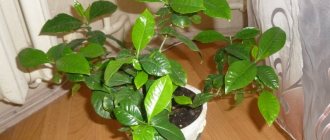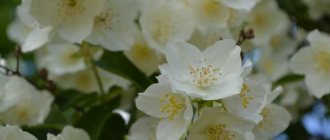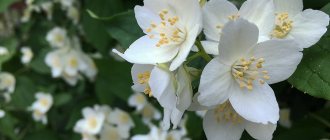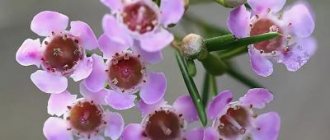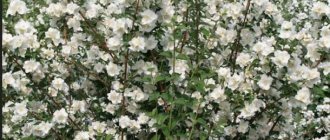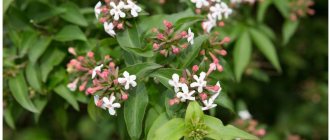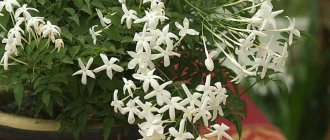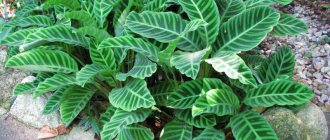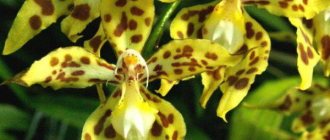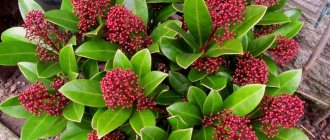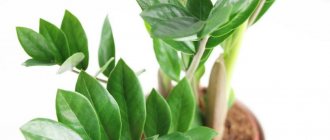The houseplant jasmine Sambac belongs to the Olive family, lives in the tropical and subtropical zones, so it is difficult to cultivate in the middle zone. All jasmines do not tolerate winter cold well, but are also vulnerable to hot wintering. Homemade jasmine Sambac is the only one that can tolerate the warm air of an apartment without losing its evergreen leaves.
Reproduction of Arabian jasmine, possible difficulties
The Arabian variety can be propagated by two methods - layering and cuttings from the mother plant. The most suitable time for reproduction is the second half of spring.
Cuttings
Cuttings are carried out in early spring or autumn. Spring cuttings are taken from a new shoot, and autumn flowers should already have dense bark. Reproduction is carried out step by step:
- the stalk is cut at the top at a right angle, and at the bottom at an angle of 45˚;
- each must have at least three growth points and 2-3 full leaves;
- planting material is placed in a special solution to accelerate root growth (for example, Kornevin);
Reproduction by cuttings - the filler for the flowerpot is prepared from river sand and a mixture of peat;
- the cuttings are planted in a flowerpot and covered with film to create greenhouse conditions;
- The optimal room temperature is within 20 ˚С.
After about 1.5 months, the cuttings will grow roots and can be transplanted to a permanent location. For better rooting, you can install additional heating from the bottom of the pot.
By layering
Reproduction by layering is a simple and convenient method. It is used if it is necessary to obtain a small number of new plants:
- During the May-June period, a small cut is made on the outermost shoot, placed in a small hole and covered with earth;
- The layering site is regularly watered. Young shoots can be expected in the fall.
When small sprouts appear, they are separated and planted in a separate container. You can buy regular flower soil with neutral acidity and add coconut fiber, peat, vermiculite, while not forgetting about a good drainage layer. You can also prepare the soil yourself, as described below.
Transfer
During its development, the shrub actively takes nutrients from the soil, so it must be replanted regularly for the next three years. In order to minimize trauma to young roots, it is recommended to replant young flowers using the transshipment method, followed by adding fresh soil to the pot. It is recommended to replant adult jasmine when the flowerpot becomes crowded or if it is affected by diseases or pests.
Before transplanting jasmine, you should take care of a suitable filler. The substrate should be chosen light so that water and air can reach the root system in sufficient quantities. Soil for Sambac can be purchased at a flower shop. Experienced flower growers recommend preparing the soil mixture yourself:
- leaf soil;
- turf land;
- peat soil;
- sand.
It is advisable to replant indoor jasmine after the end of the flowering period and after pruning. The most suitable period is the beginning of spring. Immediately after transplanting, you can sprinkle the flower with water, which will help it cope with a stressful situation. The new pot should be slightly larger than the old one, about 2-3 cm. If you take a container that is too large, the flower will stop developing. Sambac likes the soil to be almost completely filled with roots.
It will also be interesting: Begonia ever-flowering - care at home and in open ground?
Breeding
Indoor jasmine can be propagated in two ways.
Cuttings
Cuttings should be harvested in spring or summer, but do not use flowering shoots for this. It is worth giving preference to strong, woody branches. In spring, the tops should be cut off, and there should be at least 3 internodes on them. In summer, it is worth taking green young shoots. It is necessary to prepare the soil from sand, peat and leaf soil. When planting, the shoots must be deepened into the soil mixture by 2 cm, and the cut must be oblique so that they take root faster. This process will be accelerated by treating the shoots with a growth stimulant. In order for propagation from cuttings to be successful, the temperature in the room should be maintained at about +20 degrees.
Within a month, an independent plant will grow from the branch. At this time, jasmine should be replanted. The container should have a diameter of 5 cm, but no more. When the crop has formed a strong root system, you can transplant the plant into a pot with a diameter of 9–11 cm.
By layering
To propagate jasmine using this method, you should wrap the shoot at the internode with a cloth with a damp substrate or moss, but before doing this, make a vertical cut on the branch. Within a month, roots will appear at the site of the cut.
It is important to constantly maintain an increased substrate
To learn how to properly care for indoor jasmine, watch the following video.
White and other types of indoor jasmine
Indoor white jasmine is a deciduous shrub of the jasmine genus of the olive family. Known as the national flower of Pakistan. Used to make essential oil for aromatherapy. As a medicine it is used in dermatology, also used as an antiseptic and anti-inflammatory agent.
Jasmine officinalis. The most unpretentious look. Grows in almost any home environment. A liana with feathery leaves, woody stems and white flowers, which are collected in quantities of 5 to 6 pieces in racemose inflorescences.
As you can see in the photo, this indoor jasmine has small flowers - about 2.5 cm in diameter, very fragrant. It begins to bloom in adulthood and blooms throughout the summer.
It can reach a height of 10 meters if not trimmed in a timely manner. In the south of the country, in the Caucasus, it is grown in open ground for industrial use.
Holofloral jasmine. A shrubby type of plant with penetrating shoots. In winter, after the leaves fall, this type of indoor jasmine begins a flowering period; the flowers are bright yellow, located in the axils of the leaves.
Jasmine primrose - the creeping stems of the plant are usually tied to supports. The leaves are strongly elongated, dark green, pointed at the ends, arranged in groups of three. This variety of indoor jasmine has yellow, odorless branches. Blooms in summer or spring.
The Grand Duke variety of jasmine comes from Iran. It has a compact bush shape and the largest double flowers, similar to miniature roses. They stay on the shoots for a very long time without falling off, or dry up right on the bush. The smell is sweet and strong. Blooms all year round.
Beauty of India. It has oblong buds and pure white flowers up to 3 cm in diameter, emitting a sweet scent. Blooms profusely all year round. It is grown in many southern countries for the industrial production of essential oil, which is included in the most exquisite perfumes.
The royal species differs from others in its long oval leaves and large, odorless flowers, 5-7 cm in diameter, which bloom in winter.
The South African species is distinguished by long and thin tubes of flowers, and dark coloring of the feathery leaves. It blooms from November to April with clusters of white fragrant flowers.
Stellar is a fast-growing vine that climbs a support. Its profuse growth is controlled by frequent pruning. Flowers up to 5 cm, with 7-8 long petals. The aroma of the flowers is weak, which makes the plant desirable for those who do not like strong odors in the house. There are variations of it with variegated leaves.
The thinnest is a vine with thin, pubescent shoots. The leaves are opposite, simple, oval-lanceolate, 2.5-3.5 cm long, heart-shaped at the base and tapering towards the apex, light green, pubescent below.
Look at the photo - this indoor jasmine plant has white flowers collected in umbrellas, 2-2.5 cm in diameter, medium fragrant:
Blooms profusely in January-March.
Lerata is interesting because its flowers do not have a jasmine scent, but a mint scent. The stems are long, up to 3.5 m, green. The leaves are lanceolate, shiny, dark green. The flowers are small, white, waxy, star-shaped in umbellate inflorescences of 20-30 pieces.
Italian yellow. It differs from other species in its racemose inflorescence of yellow flowers with a weak aroma. It is not demanding on lighting and can bloom in winter. But with additional lighting, the inflorescences are more lush.
Oblate is a medium-sized shrub. The branches are flexible, 1.5 m long.
Pay attention to the photo - this type of indoor jasmine has odd-pinnate leaves with lanceolate leaves:
Interesting for the unusual coloring of its fragrant pale purple flowers.
Jasmine Bisa with longitudinally furrowed shoots about 1 m long. The leaves are simple, opposite, on a short petiole, slightly pubescent, ovate, 2.5-5.0 cm long, pointed, dark green. The flowers are fragrant, pink or dark pink, 1-3 at the top of the shoots. The corolla is up to 2 cm in diameter. It blooms in May.
Popular articles Why gooseberries don’t bear fruit: what to do and how to make them bear fruit
You can also grow other decorative species in the rooms: angel hair - with velvety leaves, wax, compact African, golden coastal and Molly - with white large flowers, dwarf - with yellow flowers.
Varietal varieties
Experienced gardeners know well and grow several popular varieties of jasmine sambac at home. Plants vary in size, flower complexity, and growth rate. All these types are united by white color and the fragrant smell of flowers.
Arabian Knights
The bush grows faster than other fellows; flowers are 1.5-1.7 cm in diameter and are double. Growing conditions – both sun and partial shade. Fragrant flowers adorn the branches from March to autumn.
Grand Duke of Tuscany
Middle Eastern variety of jasmine. It grows quite slowly, its incredibly large flowers reach 4-5 centimeters in coverage, they are densely double. Over the course of a year, these double roses appear on the stem for a few days and then dry up. The flowers do not fall off and can be collected and used as desired. The bush of this variety prefers dimly lit places, but also grows on windowsills on the sunny side. It is not afraid of dry soil, but a long period without watering should not be allowed. In hot weather, you need to moisturize much more often and more. The pot should have drainage holes. Fragrant, sweetish flowers are most often used to enrich tea notes and in religious services.
Maid of Orleans
A very common variety that grows quickly and is unpretentious. A climbing, creeping plant can be pruned, then it will form into a bush. The Maid of Orleans does not produce double flowers; their diameter is 20 mm. The flowers live only for a day, blooming one after another in any room conditions. Maintain a temperature of at least 10 degrees. This variety can be observed blooming all year round, but the bush is most decorative in spring and summer.
Belle of India (Beauty of India)
House plant of medium growth rate. The bush blooms all year round with terry, intricate baskets up to 30 mm. in diameter. Indiana jasmine sambac is at its most beautiful in spring and summer. A heat-loving variety, good lighting and moderation in watering are desirable.
Mali Chat
Thai variety with a slow growth rate. It has double multi-tiered flowers of small size (up to 1.5 cm). This is the most demanding variety of jasmine, although it is shade-tolerant. Growing conditions, especially the watering regime, should be carefully observed. Blooms from spring to autumn.
Care
To grow indoor jasmine, you will need to know the basics of caring for it at home, which we will talk about in more detail.
Lighting
Jasmine requires bright, diffused light. Under no circumstances place a pot with a plant on a northern windowsill - the bush is unlikely to please you with its flowers due to lack of sun. If you placed the flower in the south, be sure to shade the window to prevent sunburn. The most optimal place would be an eastern or western window.
In spring and summer, you can move the bush to the balcony or veranda, but you need to gradually accustom it to new conditions.
Temperature
The optimal temperature for indoor jasmine during the warm period is 18-25 degrees.
With the onset of cold weather, prepare the jasmine for winter by lowering the temperature to 8-10 degrees - this condition is necessary for the subsequent flowering of the shrub. The only variety that does not require coolness in winter is Sambac jasmine.
Humidity and watering
Like all indoor flowers, jasmine will require intensive watering in spring and summer. The procedure must be carried out when the top layer of soil dries. Watering should be adjusted from the very first days and the substrate in the pot should not be allowed to dry out or become waterlogged.
To water indoor jasmine, use only filtered boiled or rain water.
An important task is to ensure sufficient air humidity, because... in dry conditions, the bush will not only not bloom, but will also become vulnerable to attacks by pests, after which it may even die. Spray the bush regularly, but remember that moisture should not get on the flowers.
What to feed?
For fertilizing, use complex fertilizers - they will saturate the soil with useful substances and help achieve lush flowering.
Liquid fertilizers have a beneficial effect on jasmine, because... The shrub does not respond well to long-term fertilizing. Remember that during active growth, the flower needs regular fertilization - at least once a week, and at the end of flowering the procedure should be stopped.
How to replant?
At first, jasmine will need annual replanting, but older specimens should be replanted only once every 3-4 years.
You must proceed as follows:
Prepare a new pot in advance, which should be no more than 2-3 cm in volume. Place drainage at the bottom. Water the bush well and carefully remove it from the pot along with the earthen lump
Plant the jasmine in a new location, adding fresh soil and gently pat it down with your hands. At the end of the transplant, water the plant and place it in its usual place.
Priming
In order for the shrub to take root, you should carefully select the composition of the soil. You will need neutral or slightly acidic soil. The composition is as follows: peat, leaf and turf soil, greenhouse substrate.
All components must be mixed in equal proportions and add ½ part of river sand. If you don’t want to prepare the substrate yourself, just purchase a universal mixture for planting indoor flowers.
What soil do you prefer to use?
PurchasedI make my own
Pot
A pot that is too spacious for planting indoor jasmine will not work, because... a large amount of substrate will lead to acidification of the soil. It is better that the roots of the plant completely entwine the earthen ball.
How to trim?
Jasmine will need regular pruning, which, however, it tolerates well. Shaping pruning will help maintain the natural beauty of the bush. The main task of the gardener is to trim all damaged, elongated and dry shoots, as well as branches with deformed leaves.
Expert opinion Vera Ivanovna Sh Since childhood, she was fond of growing indoor flowers, then she decided to devote her life to landscape design and gardening.
The procedure is carried out in the spring, and you will have to cut about ½ or 1/3 of the length. If the bush is young (no higher than 50-60 cm), then pruning should not be done, but should be limited to pinching the tops.
After correct and timely pruning, jasmine appears with many side branches, on which buds in turn form.
Recommendations
- ^ a b
"
Jasmine sambac
(L.) Ayton".
Germplasm Resources Information Network (GRIN)
. Agricultural Research Service (ARS), United States Department of Agriculture (USDA). Retrieved March 8, 2011. - Gines Lopez Gonzalez (2006). Los árboles y arbustos de la Península Ibérica e Islas Baleares: especies silvestres y las principalales cultivadas
(in Spanish) (2nd ed.). Mundi-Prensa Libros. item 1295. ISBN 978-84-8476-272-0. - " Jasmine sambac
(L.) Aiton, Oleaceae." Pacific Island Ecosystems at Risk (PIER). October 18, 2006. Retrieved May 8, 2011. - " Jasmine sambac
".
Missouri Botanical Garden
. Retrieved November 25, 2022. - Olveros-Belardo, Luz; Smith, Roger M.; Ocampo, Milagros P. (990). "Some components of the absolute rowers Jasmine sambac
(l.) Ait" (PDF).
Proceedings of the National Academy of Sciences and Technology
.
12
(6): 129–140. - ^ a b c d f f
Fernando S. Sanchez Jr.;
Dante Santiago; Caroline P. He (2010). "Jasmine ( Jasmine sambac
(L.) Ayton) production management practices in the Philippines" (PDF).
Journal of the International Society of Agricultural Sciences of Southeast Asia
.
16
(2): 126–136. Archived from the original (PDF) on June 28, 2011. Retrieved May 8, 2011. - Checklist of selected Kew World plant families
- Pangilinan Jr., Leon (October 3, 2014). "In Focus: 9 Facts You May Not Know About Philippine National Symbols." National Commission for Culture and the Arts. Retrieved January 8, 2022.
- ^ a b
Baby P. Scaria (2007).
Aromatic Plants: Vol.01.
Horticultural Science Series .
The Science of Gardening
.
Families and genera of vascular plants. 1
. New India Publishing House. p. 182. ISBN 978-81-89422-45-5. - ^ a b c
"
Jasmine sambac
(Linnaeus) Ayton, Hort. Q. 1: 8. 1789 ". Flora of China. Retrieved May 8, 2011. - ^ a b c d f f
Kenneth W. Leonhardt;
Glenn I. Teves (2002). "Pikake - A Plant with Fragrant Flowers for Landscape and Lei Making" (PDF). Ornaments and flowers
. College of Tropical Agriculture and Human Resources (CTAHR), University of Hawaii at Manoa. Retrieved May 8, 2011. - ^ a b
B.K. Banerjee; A.K. Dwivedi. "The Fragrant World of Jasmine." Floriculture Today, National Botanical Research Institute. Archived from the original on December 7, 2010. Retrieved May 8, 2011. - Klaus Kubicki; Joachim W. Cadereit, ed. (2004). Families and genera of vascular plants: flowering, dicotyledonous.
Lamiales (except Acanthaceae, including Avicenniaceae) .
Families and genera of vascular plants. 7
. Springer. p. 299. ISBN 978-3-540-40593-1. - " Jasmine sambac
(L.) Aiton: Arabian jasmine." PLANT Profile, Natural Resources Conservation Service, USDA. Retrieved May 8, 2011. - ^ a b c
胡秀英 (Hu Shiu-Yin) (2003).
秀苑擷英
秀苑擷英: 胡秀英敎授論文集 (in Chinese and English).中 (香港). pp. 263–265. ISBN 978-962-07-3152-5. - A.K. Singh (2006). Flower crops: cultivation and care
. New India Publishing House. pp. 193–205. ISBN 978-81-89422-35-6. - Etymological Dictionary of the French Original of the East
, L. Marcel Devic, 1876, p. 201;
downloadable. Additional information on Zambacca (Alfita, mid-15th century); sambac (Simon of Genoa, late 13th century); زنبق = دهن الياسمين ( Zanbak
= "jasmine oil" in
Lisan al-Arab
, late 13th century). - William Ayton (1810). Hortus Kewensis, or Catalog of Plants Grown at the Royal Botanic Gardens, Kew.
.
1
(2nd ed.). Longman. paragraph 16. - ^ a b
Tony Walsh (2004).
"Jasmine Fragrances of Arabia" (PDF). Arab News Review
. Saudi Research and Publishing Company (SRPC): 1–3. ISSN 0254-833X. Retrieved May 8, 2011. - "RHS Plantfinder - Jasmine sambac
." Retrieved March 14, 2022. - "AGM Plants - Ornamental" (PDF). Royal Horticultural Society. July 2022. p. 56. Retrieved March 14, 2022.
- ^ a b c d f
“Jasmine”. Houseplants, HCC Southwestern College. Archived from the original on May 8, 2011. Retrieved May 8, 2011. - Ali Esmail al-Snafi (2018). "Pharmacological and therapeutic effects of Jasmine sambac
- Review."
Indo Am.
JP Sci .
05
(3). - Santhanam, Jacinta; Ghani, Farhana Nadia Abd; Basri, Dayang Fredalina (2014). “Antifungal activity of Jasminum sambac against Malassezia sp. and Non-Malassezia sp. isolated from human skin samples." Journal of Mycology
.
2014
: 1–7. doi:10.1155/2014/359630. ISSN 2356-7481. - "Philippine Fast Facts: National Flower: Sampaguita." National Commission for Culture and the Arts, Republic of the Philippines. Archived from the original on September 15, 2008. Retrieved May 8, 2011.
- ^ a b
"National Flowers of ASEAN". ASEAN Secretariat. Retrieved May 8, 2011. - ^ a b c
W. Arthur Whistler (2000).
Tropical Ornamental Plants: A Guide
. Timber Press. pp.284–285. ISBN 978-0-88192-475-6. - Lim, T. (2014). Edible medicinal and non-medicinal plants
. Volume 8, Flowers. Springer. item 530. ISBN 9789401787482. - Teresita L. Rosario. "Cut flower production in the Philippines." Food and Agriculture Organization of the United Nations. Retrieved May 8, 2011.
- Greg Nickles (2002). Philippines: people
. Lands, peoples and cultures. Crabtree Publishing. paragraph 27. ISBN 978-0-7787-9353-3. - Robert H. Boyer (2010). Sunday in Manila
. UP Press. p. 230. ISBN 978-971-542-630-5. - Himig: FHL Philippine Music Collection. "Dolores Paterno." Philippine Heritage Library and Ayala Foundation. Retrieved September 26, 2011.
- Concepcion, Pocholo (22 May 2012). "Lady Gaga strips off in advert for her first fragrance 'Fame' (poll)." inquirer.net
. Philippine Daily Inquirer. Retrieved July 4, 2022. - Garcia, Maria Angelica (October 24, 2022). "SEA Games Torch Inspired by Sampaguita." GMA News
. Retrieved November 30, 2022. - Agliboth, Joanna Rose (23 August 2022). "Sampaguita-style torch ready for the 30th Sea Games." Philippine Daily Inquirer
. Retrieved November 30, 2022. - Keputusan President No. 4 Tahun 1993 Archived April 2, 2012 Wayback Machine
- Toto Soutater; Kusumah Effendi. "Cut flower production in Indonesia." Food and Agriculture Organization of the United Nations. Retrieved May 8, 2011.
- Melati Suchi
- James H. Vandersee; Renee M. Clary. "Divinity in embryo." Project Human Flower. Retrieved May 8, 2011.
- https://zenodo.org/record/1210527/files/57.Jasminum sambac.pdf
Reproduction
Garden jasmine is propagated in different ways, starting from seed. It is the longest and most labor-intensive, because from the moment of planting to an adult plant capable of flowering, it takes 7-8 years. At the same time, bushes grown in this way are the most resistant to diseases, pests and various kinds of negative influences. Jasmine seeds are sown on previously prepared soil in late autumn - early winter, before the onset of severe frosts, but at a time when there is already snow. If there is not enough of it, it is specially placed on the beds on top of the seeds. The snow cushion should be 15 cm thick. The seeds are placed on prepared soil, then covered with spruce and snow. The process of overwintering seeds at sub-zero temperatures is called stratification. After this, their germination and durability increase. In the spring, when the snow begins to melt, it will saturate the soil with moisture, which will “drag” the seeds with it. With the beginning of the growing season, young shoots will appear. Seeds are also often used to grow jasmine at home. In this case, an adult flowering plant grows much faster than in the garden.
It is much easier, more reliable and faster to propagate jasmine by cuttings. Young shoots are harvested in early summer. They should be flexible - not break when bent into a ring. The cuttings are cut obliquely in the morning, when there is enough moisture in the branches. To reduce water evaporation, the lower leaves on the cuttings need to be torn off and the upper ones shortened by half. To speed up the root formation process, it is recommended to keep the cuttings for about a day in a solution of a special preparation, and then plant them in a greenhouse, deepening them a few centimeters. If there is no greenhouse, a greenhouse can be built from available materials - for example, cover the cuttings with cut bottles. The bottles cannot be removed for the first 2-3 days, and then they will need to be ventilated daily. Spray and water regularly to maintain high humidity, but do not turn the soil into a swamp. During this period, the cuttings should receive enough light, but they should not be placed in direct sunlight. After two weeks, a root system should form.
Cuttings for propagating jasmine can also be taken in the fall. Cut branches 15 cm long should be put in a box, sprinkled with clean sand, and then sent to a cool place to winter. In the spring, before the buds appear, they are placed in the garden bed, rooted in the same way as young cuttings. By autumn the plant should be sufficiently strong. A slightly more complex method, but one that gives better results, is propagation by layering. It is held in the summer. Young shoots growing around the mother bush are suitable for this. Such a shoot is tied with wire under its lower bud. This action stimulates the formation of roots. Then the shoot is bent to the ground itself, to a prepared small hole, fixed with wire and sprinkled with soil. In the place where the future bush allocated for planting comes into contact with the soil, roots should appear. This happens within a month. Soon new shoots appear around the rooted cuttings. For better development of the root system, they are hilled several times during the summer. By autumn, a young bush is usually strong enough to exist independently. It needs to be cut off from the mother plant, dug up and planted in a new place.
Popular articles Champignon mushrooms during pregnancy, when and in what form you can eat them
The method is good for low-growing bushes, but for plants 2-4 m high it is clearly not suitable. The bush needs to be dug up and divided into two or more parts so that each part has young growth. This is done with the help of garden pruners in the fall (usually in October), when the plant is preparing for the dormant period. Then the “dividers” are seated in new places.
Common varieties
There are several varieties of ornamental shrubs that are especially loved by gardeners for their beauty and unpretentiousness.
Sambac
Sambac, or fragrant jasmine, is an evergreen climbing or climbing shrub. The leaves are odd-pinnate, simple, ovoid, leathery, arranged oppositely. The length of the leaf blade is from 2 to 10 cm.
Sambac
The flowers are double or semi-double, pure white, yellow or red. The most common variety is Sambac Grand Duke, a capricious plant with amazingly beautiful double flowers.
For your information. An interesting feature of this species is that its superior ovary forms a berry, which makes the plant more decorative.
With proper care, Sambac jasmine will bloom all year round.
Pink jasmine
A beautiful climbing shrub plant with pink fragrant flowers, capable of decorating both an apartment and a country house. Pink jasmine blooms from early May to mid-July. Distributed in Crimea.
Pink jasmine
Interesting. In addition to its decorative function, the bush also brings practical benefits: its parts are used in medicine and perfumery.
Madagascar jasmine
Stephanotis, or Madagascar jasmine, is a tropical exotic with bright greenery and white or purple flowers. Under natural conditions, jasmine vines reach a length of 6 m. The inflorescences are loose, containing 5-7 flowers.
Madagascar stephanotis
The plant requires care and attention, but it cannot be called too capricious.
Jasmine multiflorum
Known under the names polyanthus, Polyantum. A beautiful, densely branching shrub, the branches of which reach a length of 2 m. The leaves are complex, pinnate, and have an opposite arrangement. The plant blooms from February to August. The petals are painted white, at the bud stage - pink. Inflorescences are located along the entire length of the branches.
Polyantum
After flowering, multi-flowered jasmine produces fruits in the form of black berries.
Jasmine holoflora
This plant is sometimes called winter jasmine for its ability to bloom in late February. At this time, thin drooping branches are covered with small yellow flowers, which looks especially impressive against the background of dark coniferous trees or hedges. Holofloral ornamental jasmine is unpretentious, tolerates pruning well, and is undemanding to soil composition.
Holofloral bush
Only yellow-leaved jasmine, a member of the mock orange family, can compete with it in beauty.
Yellow jasmine
This variety is a shrub with erect shoots up to 1.5 m in height. The leaves are rich green in color and arranged oppositely. The flowers smell wonderful and are colored in a bright lemon shade.
Jasmine yellow
At the end of summer, small black shiny berries appear on the branches of yellow jasmine.
Strawberry jasmine
Strawberry jasmine is sometimes called false jasmine, because this species belongs to mock oranges, which is a different botanical family. If this plant received the name “jasmine” for its external resemblance to Olives, then the additive “strawberry” was given to it for its aroma.
Strawberry mock orange
Scented flowers on a small compact bush look very elegant.
Jasmine Virgin
When deciding to grow shrubs at home, it is worth keeping in mind that some varieties are quite tall and actively grow. This includes Jasmine Virgin. This is a branching shrub with dense green foliage and white double flowers that exude a delicate aroma. It is thermophilic and prefers well-lit places, but it can also tolerate cold quite well.
Virgin
Important! It is not advisable to place a flowering plant in the bedroom. The strong smell of flowers can cause headaches
Indoor jasmine - home care, photos, propagation
The jasmine genus from the Olive family (Oleaceae) includes about 200 species of evergreen or deciduous vines and shrubs that grow naturally in tropical and subtropical regions of Europe and Asia.
It is often confused with garden mock orange, although the botanical characteristics of these plants are different. Of the representatives of the genus, only two species are successfully grown in indoor culture.
Caring for indoor jasmine involves following rules that will help the plant feel comfortable at home.
Jasmine attracts gardeners with its fragrant white or pinkish flowers that appear at the top of the current season's shoots. Flowering plants are usually sold from December to the end of April.
Chemical composition
Jasmine sambac
contains dotriacontanoic acid, dotriacontanol, oleanolic acid, daucosterol, hesperidin, and [+] - jasminoids A, B, C, D in its roots.
Rutin, quercetin, isoquercetin, quercetin-3-dirhamnoglycoside, kaemferol-3-rhamnoglycoside, α-amyrin, β-sitosterol were found in the leaves. A new plant cysteine-rich peptide family called jasminthids has been isolated from this plant. Its aroma is due to various compounds, including benzyl alcohol, tetradecamethylcycloheptasiloxane, methyl benzoate, linalool, benzyl acetate, (-)-( p
)-jasmine lactone, (
E
,
E
)-α-farnesene, (
Z
)-3-hexenyl benzoate, N -acetylmethyl anthranilate, dodecamethylcyclohexasiloxane, (
E
)-methyl jasmonate, benzyl benzoate and isophytol.[24][
questionable - discuss
]
Jasmine sambac
has been shown to have antifungal activities.[25]
Description
Jasmine sambac is an evergreen climbing plant or shrub reaching a height of 0.5-3 meters. The species is highly variable, possibly as a result of spontaneous mutation, natural hybridization and autopolyploidy. Cultivated sambac usually bears no seeds, and the plant reproduces exclusively by cuttings, layering, market and other asexual propagation methods.
The leaves are ovate, from 4 to 12.5 cm in length and from 2 to 7.5 cm in width. Phyllotaxy is opposite or in three simple whorls (not pinnate, like most other jasmines). They are smooth except for a few hairs on the veins at the base of the leaf.
Flowers appear throughout the year and in groups of 3 to 12 together at the ends of branches. They are strongly scented, with a white corolla 2 to 3 cm in diameter with 5 to 9 petals. The flowers open at night (usually around 6-8 pm) and close in the morning at intervals of 12 to 20 hours. The fruits are purple to black berries and 1 cm in diameter.
Content
- 1 Description
- 2 Taxonomy and nomenclature
- 3 Cultivation 3.1 Varieties
- 5.1 Southeast Asia 5.1.1 Philippines
- 5.2.1 China
- 5.5.1 Sri Lanka
Indoor multifloral jasmine is an unusual indoor plant.
This attractive indoor plant is native to China. For normal growth and development, he needs good support. Due to the flexibility of the shoots, they can be braided around a support. During flowering, multiflora jasmine is strewn with small fragrant flowers. Caring for jasmine at home will not be difficult, since indoor jasmine is an unpretentious houseplant.
This indoor plant has leathery leaves that are dark green in color. Each leaf consists of seven small leaflets, very similar to ferns. This is a fast growing houseplant. Its shoots curl and wrap around each other, so take care of support in advance. In a year it can grow up to two meters. If you need to decorate a room, then guide the shoots along the supports, creating the look you want, or we cut the shoots, thus preventing the plant from growing. Pruning will keep the plant compact and encourage the development of new shoots. Keep an eye on indoor jasmine, since it is climbing, you may miss the moment of pruning and your jasmine at home will grow greatly.
Abundant flowering occurs in winter. The inflorescences remain on the plant for a long time, almost until the very beginning of spring. Jasmine flowers themselves are small.
The decorative nature of the inflorescences lies in the fact that the closed buds have a pinkish tint; after blooming for a while, the inflorescences become snow-white.
Young jasmine flowers bloom more profusely than adults. If possible, take your jasmine out into the fresh air. In the fresh air, the plant will grow faster and produce new shoots, on which inflorescences will then appear.
Since multifloral jasmine grows quickly, it needs support. It is better to install supports when the plant is young. After flowering, we carry out formative pruning. To do this, the shoots can be removed from the support and trimmed, then secured to the support again.
To do this, carefully remove the shoots from the support, trying not to break the fragile shoots. We trim enough and a lot, leaving only a couple of young side shoots
We braid the jasmine support; if necessary, the shoots can be secured. Thanks to this pruning, multifloral jasmine will develop and grow faster.
General information
Indoor jasmine is a beautifully flowering plant with a fragrant scent. Buds are white, yellow, pink. The flower, as a decorative decoration, is popular not only among flower growers. Lovers of aromatic tea will not confuse jasmine with anything else.
According to professionals, jasmine does not involve complex breeding processes. Therefore, amateur flower growers can safely start growing the crop. Limnanthes can also be easily grown.
Medicinal, healing and beneficial properties of jasmine
Alternative medicine healers use jasmine as dietary supplements. In folk medicine, the stems, flowers and leaves of the plant are successfully used to prepare ointments, tinctures, and decoctions for various diseases.
In traditional medicine, the leaves are used to produce antipyretic drugs. To increase lactation, during breastfeeding, women drink jasmine tea. Sores and wounds on the body are treated with compresses made from the jasmine plant. Jasmine root will help relieve headaches and insomnia. It will also relieve painful swelling from fractures and bruises. The listed qualities are not the limit of possessing the miraculous properties of jasmine.
Essential jasmine oil is a good antidepressant, a nervous system restorer, and is suitable for various mental disorders. And finally, jasmine will come in handy for preparing a fragrant, soothing bath.
Varieties
There are more than 200 varieties of indoor jasmine in nature. The flower is grown both outdoors and indoors in flower containers.
Royal jasmine is a popular type of indoor plant. The plant is large in volume, the girth of the vine reaches up to 5 centimeters. Blooms in winter, without a pronounced scent. Another variety is multi-flowered. It is boldly called a long-liver. An evergreen shrub with flexible stems that need support. The flowers are like stars, collected in snow-white inflorescences of buds. It can provide color all year round, but mostly blooms in the spring.
Jasmine Sambac is the only type of jasmine that can winter comfortably at room temperature. It is considered the most unpretentious variety of all types of indoor jasmines. The shape resembles an evergreen shrub, growing up to 3 m in height. It blooms from spring to autumn, emitting a strong and pleasant aroma. The flowers resemble white roses in appearance. In industry, sambac flowers are included in the composition of perfumes. A peculiar variety “Jasmine Golotsvetkovy”. Small indoor shrub. Bright yellow large flowers grow on branches with small leaves. Blooms from mid-winter to mid-spring. A native of Northern China and Transcaucasia, “Japanese jasmine” is a creeping variety with delicate yellow flowers and no distinct odor.
Jasmine "Bissa" will decorate an area of almost 2 meters on the wall with branches with lush green small leaves and large pink inflorescences. The aroma of "Bissa" is intense and does not bloom for long. Jasmine will not cause much difficulty in breeding
The attention that will have to be invested will be justified by the gift of beauty, comfort, and fragrance.
Jasmine flower
An interesting fact to note about jasmine flowers. The plant has pistils and stamens, but they do not develop evenly. For this reason, jasmine does not self-pollinate. Jasmine is pollinated exclusively by insects. After pollination, the flowers turn into dark-colored berries.
When choosing a plant variety for growing jasmine at home, keep in mind the fact that there are fragrant varieties of jasmine, and there are also odorless ones.
Diseases and pests
Among the harmful insects that attack jasmine, it should be noted:
- Weevil. To get rid of the pest, spray the bush with mustard tincture - 10 liters. water you will need 1 package of dry powder.
- Aphid. In this case, spraying will also help, but only with a soap solution. Simply dissolve 1 bar of laundry soap (72%) in 10 liters. water.
- Whitefly. You can eliminate the parasite using yarrow tincture - take 500 g of chopped herb, pour 10 liters. water and let it brew for 5 days. The natural and effective drug is ready!
Remember that if you properly care for your flower, you won’t have to treat it.
Why doesn't it bloom?
The lack of flowering indicates, first of all, improper care, namely:
- Incorrect planting of the bush, in which the neck of the trunk was buried more than 3 cm.
- A small amount of nutrients in the soil that are necessary for normal growth and flowering. Feed the plant regularly using special products.
- Dim or, conversely, excessive lighting, in which burns form on the leaves and the buds dry out and fall off.
- The temperature regime, on which the healthy development of the flower, and, consequently, flowering, depends, is not regulated.
- Poor watering, when the earthen ball dries out and the buds do not have enough moisture to bloom.
- Jasmine is affected by harmful insects that feed on the sap of the bush.
- The substrate contains lime. The reason may be unfiltered water used for irrigation.
Thus, by adjusting the growing conditions for jasmine, you will definitely achieve beautiful flowering.
Popular articles Rose Claire Austin
Why do the leaves turn yellow?
If you notice yellowing leaves on a shrub, you should adjust the conditions under which the plant is kept. The main reasons for this condition may be:
Poor lighting, which leads to a decrease in the brightness of the leaves. Fixing the problem is not difficult - just choose a more illuminated place for the pot. Failure to comply with the recommended temperature for growing a flower. Remember that this indicator should not be lower than +15°C and higher than +25°C. Hard water for watering plants. Stagnation of fluid in jasmine roots, which can also lead to yellowing of the foliage. Remember to drain the excess from the tray and create a good drainage layer at the bottom of the pot. Bright sun leading to foliage burns. Do not forget to shade the flower during periods of solar activity. Dry indoor air
In this situation, it is important to organize spraying of the bush or give it a warm shower. Attack of harmful insects that should be eliminated immediately
Don’t forget to also send the pot with the plant to “quarantine”, away from other indoor inhabitants.
Expert opinion Vera Ivanovna Sh Since childhood, she was fond of growing indoor flowers, then she decided to devote her life to landscape design and gardening.
Regularly inspect the flower for dried leaves and shoots, prune on time, and do not neglect the care recommendations to prevent yellowing of the leaves.
By following simple rules for caring for indoor jasmine and knowing the characteristics of this plant, there will be no difficulties in growing and propagating the flower at home. Timely pruning and replanting, as well as the prevention of possible diseases, will help achieve good results, and the plant will delight with its beauty for many years.
Common varieties
There are several varieties of ornamental shrubs that are especially loved by gardeners for their beauty and unpretentiousness.
Sambac
Sambac, or fragrant jasmine, is an evergreen climbing or climbing shrub. The leaves are odd-pinnate, simple, ovoid, leathery, arranged oppositely. The length of the leaf blade is from 2 to 10 cm.
Sambac
The flowers are double or semi-double, pure white, yellow or red. The most common variety is Sambac Grand Duke, a capricious plant with amazingly beautiful double flowers.
For your information. An interesting feature of this species is that its superior ovary forms a berry, which makes the plant more decorative.
With proper care, Sambac jasmine will bloom all year round.
Pink jasmine
A beautiful climbing shrub plant with pink fragrant flowers, capable of decorating both an apartment and a country house. Pink jasmine blooms from early May to mid-July. Distributed in Crimea.
Pink jasmine
Interesting. In addition to its decorative function, the bush also brings practical benefits: its parts are used in medicine and perfumery.
Madagascar jasmine
Stephanotis, or Madagascar jasmine, is a tropical exotic with bright greenery and white or purple flowers. Under natural conditions, jasmine vines reach a length of 6 m. The inflorescences are loose, containing 5-7 flowers.
Madagascar stephanotis
The plant requires care and attention, but it cannot be called too capricious.
Jasmine multiflorum
Known under the names polyanthus, Polyantum. A beautiful, densely branching shrub, the branches of which reach a length of 2 m. The leaves are complex, pinnate, and have an opposite arrangement. The plant blooms from February to August. The petals are painted white, at the bud stage - pink. Inflorescences are located along the entire length of the branches.
Polyantum
After flowering, multi-flowered jasmine produces fruits in the form of black berries.
Jasmine holoflora
This plant is sometimes called winter jasmine for its ability to bloom in late February. At this time, thin drooping branches are covered with small yellow flowers, which looks especially impressive against the background of dark coniferous trees or hedges. Holofloral ornamental jasmine is unpretentious, tolerates pruning well, and is undemanding to soil composition.
Holofloral bush
Only yellow-leaved jasmine, a member of the mock orange family, can compete with it in beauty.
Yellow jasmine
This variety is a shrub with erect shoots up to 1.5 m in height. The leaves are rich green in color and arranged oppositely. The flowers smell wonderful and are colored in a bright lemon shade.
Jasmine yellow
At the end of summer, small black shiny berries appear on the branches of yellow jasmine.
Strawberry jasmine
Strawberry jasmine is sometimes called false jasmine, because this species belongs to mock oranges, which is a different botanical family. If this plant received the name “jasmine” for its external resemblance to Olives, then the additive “strawberry” was given to it for its aroma.
Strawberry mock orange
Scented flowers on a small compact bush look very elegant.
Jasmine Virgin
When deciding to grow shrubs at home, it is worth keeping in mind that some varieties are quite tall and actively grow. This includes Jasmine Virgin. This is a branching shrub with dense green foliage and white double flowers that exude a delicate aroma. It is thermophilic and prefers well-lit places, but it can also tolerate cold quite well.
Virgin
Important! It is not advisable to place a flowering plant in the bedroom. The strong smell of flowers can cause headaches
Features of planting and soil preparation
As mentioned earlier, heat-loving Sambac takes root best at home: on closed terraces, in greenhouses or on a windowsill in an apartment. In order for a plant to grow, develop and bloom, the correct approach to planting and soil selection is necessary.
So, neutral soil with low acidity is suitable for jasmine. At the same time, it must be light, porous, and contain sand, peat and humus. It is best to use ready-made soil mixtures from the store, this will reduce the likelihood of the flower becoming infected with various diseases. You will also need expanded clay, which will perform a drainage function, and a container for planting.
The container for planting a seedling should not be very large; a container with a volume of 2–2.5 liters is suitable. A layer of expanded clay (about 2 cm) is poured onto the bottom of the flowerpot, then filled halfway with soil, jasmine is planted, sprinkled with the rest of the soil and watered. Young seedlings should be kept at a temperature of +18. +20ºC away from drafts and direct sunlight.
Problems during cultivation
If sambac sheds its leaf blades, then the source of the problem may be excessive moisture, drying out of the soil, or low air humidity. What to do in this situation is, in principle, clear - to balance the out-of-control aspect of cultural life.
Dry ends of leaves and shoots are again characteristic of low humidity or insufficient watering. When the branch dries out completely, the problem may lie in the use of hard water for irrigation and the accumulation of alkali in the ground.
What to do if jasmine does not bloom?
There may be several reasons for this:
- insufficient soil moisture;
- dry or cold indoor air;
- soil is not acidic enough;
- using chlorinated tap water to moisten the soil;
- deepening the root collar when planting in the soil by more than 3 cm.
By eliminating these causes and providing proper care, such a shrub will bloom for many years.
Planting and care
Outdoor varieties of jasmine sambac are grown in southern climates, and in central Russia it grows well at home. Plant it in a tub or container and take it out into the garden and onto the terrace for the summer. We carry it indoors for the winter right in the tub.
The soil
The soil needed is light, with the addition of humus and sand. You can purchase ready-made soil at a gardening store. If we prepare the mixture ourselves, then we mix garden soil with peat and sand in a ratio of 1:1:1. The soil reaction is neutral or slightly acidic.
Planting and transplanting
We take the first pot for a small plant with a volume of 1.5-2 liters. Lay out a drainage layer and add earthen mixture.
Reproduction
Under cultural conditions, jasmine sambac propagates only vegetatively, namely by cuttings. This procedure is carried out in the spring or during the summer season.
- · We take semi-lignified cuttings with two or three internodes;
- · Dip into a solution of heteroauxin or other growth stimulant;
- · Plant in a container with peat or wet sand;
- · Cover the container with a bag or glass, creating a moist, warm environment;
- · The roots will begin to sprout within 1-1.5 months.
The percentage of rooted specimens varies, sometimes it is only half of the planting material. We plant shoots with roots in small pots for independent growth.
Top dressing
Since the pot contains a small volume of soil, jasmine needs regular fertilizer. Once a month (from March to October) we feed the plant with a mineral mixture containing phosphorus, potassium, and nitrogen. During flowering, we reduce the share of the latter. It is better to use slow-soluble granular fertilizers.
If the soil is deprived of minerals, the plant may stop blooming and begin to shrink. With an excess of fertilizers, yellowing and falling leaves are observed.
Requirements for watering and air humidity
Homemade jasmine does not like heavy watering, but the Maid of Orleans and Grand Duc varieties can tolerate a little dryness. Watering should be done with soft, slightly acidified water at room temperature.
The foliage of the plant responds to regular spraying. Tropical sambac will be grateful for the increased air humidity.
What lighting and temperature do you need?
The ability to grow under bright sunlight is another feature of jasmine. The light-loving bush can be taken out to a balcony or open area in the summer. If you want to speed up and prolong flowering, you will need additional lighting in spring and autumn.
Without sufficient light, the plant is depressed and may die. Jasmine is suitable for the temperature regime of the apartment; in winter it does not need to be placed in a cool room below 10-15 degrees. Drafts are also contraindicated for this culture.
How and why to prune
This vine-like plant needs to be pruned regularly if you want to have a compact, lush habit.
In addition to sanitary removal of branches, formative pruning is also carried out.
- In March-April, weak, thin, broken or dried branches are completely removed;
- Long shoots are trimmed with scissors or pruning shears by half or two-thirds of the stem;
- After flowering, also pinch and trim the branches.
Pruning stimulates the growth of side shoots and promotes flowering. Those shoots that are left to curl need to be supported.
What is Sambuca
There are two main hypotheses for the origin of the generic name elderberry (Sambucus). Most linguists associate it with the sambuza, an ancient Greek musical instrument that was made from the shoots of this deciduous shrub. According to another version, sambucus could get its name from the designation of red paint in ancient Greek - sambyx. The common people had many definitions of this plant, such as “tubular tree”, “maiden sambuca”, “buchkan”, “squeaker” and even “tree of fate” and “old lady”. One of the names for elderberry is “witch tree.” In ancient times, many mystical properties were attributed to the bush with black berries. Sambuca was associated with misfortune - it was believed that witches rode on it. Popular beliefs prescribed not to burn elderberry brush in the house, so as not to cause trouble. On the other hand, the elder symbolized fertility and love. The ancient Slavs believed that a sambuca bush near the house would protect the family from evil spirits (“In the garden it will protect both the garden and the house; under the bed – sleep”). The property of elderberry branches is known to scare away mice, which were considered magical animals (mediators between the world of the dead and the living). And today, many owners put sambuca branches in country houses and pantries to get rid of rodents. Cockroaches, flies and some garden pests also cannot stand the smell of this plant. If only folk legends are associated with the magical properties of elderberry, then many of the nutritional and healing properties of this plant have been proven by modern science. It is recommended to use black elderberry (Sambucus nigra) as a medicine, while red elderberry (Sambucus racemosa) is considered a poisonous plant. How to distinguish varieties of sambuca? Elderberry is a bush or small tree that can grow from 3 to 7-10 meters in height. The trunk and old wood are distinguished by cracked light-ash bark, young shoots are covered with brown lentils. The core of the bush is loose, the leaves have a complex serrated shape. In June, elderberry blooms small yellowish inflorescences that emit a pungent odor. Sambucus nigra (black elderberry) has fruits that are spherical drupes of black-violet color, on long stalks. They are full of bloody black juice. Sambucus racemosa (red elderberry) is distinguished by its small, shiny, red berries. Elderberries are juicy and sweet and sour in taste. They contain essential oils, carotene, tannins, vitamin C and many other beneficial nutrients. The fruits are most often eaten in processed form. They can be dried, cooked into berry jam, marmalade and jelly. In winemaking, black elderberry juice and flowers are used as a natural coloring and flavoring agent. In principle, everything in Sambucus nigra is valuable - the flowers give alcoholic drinks a nutmeg aroma; buds and bark contain tannins and essential oil; young shoots are even peeled from the bark and eaten boiled or in a marinade. An aromatic tea is prepared from elderberry blossom; the roots are used for healing decoctions and tinctures. Sambuca is primarily a medicinal plant, so you should not eat it in large quantities or haphazardly. Dry berries, flower buds and flowers are most often used as medicinal raw materials in modern medicine. The raw materials are dried in the shade in the fresh air or in special dryers at a temperature of 30 to 35 degrees, then crushed. Used in the form of tinctures, mixing with water 1:10 or tea (1 tablespoon of dry raw materials per 200 g of boiling water). Your doctor may prescribe elderberry as a diuretic, diaphoretic, or anti-inflammatory; for rinsing with laryngitis and sore throats. In addition, the healing properties of sambuca are used for diseases of the gastrointestinal tract, rheumatism, gout, hemorrhoids, diabetes and many other diseases. Elderberry can still be called a magical plant today - for this it is not at all necessary to believe in white and black magic.
